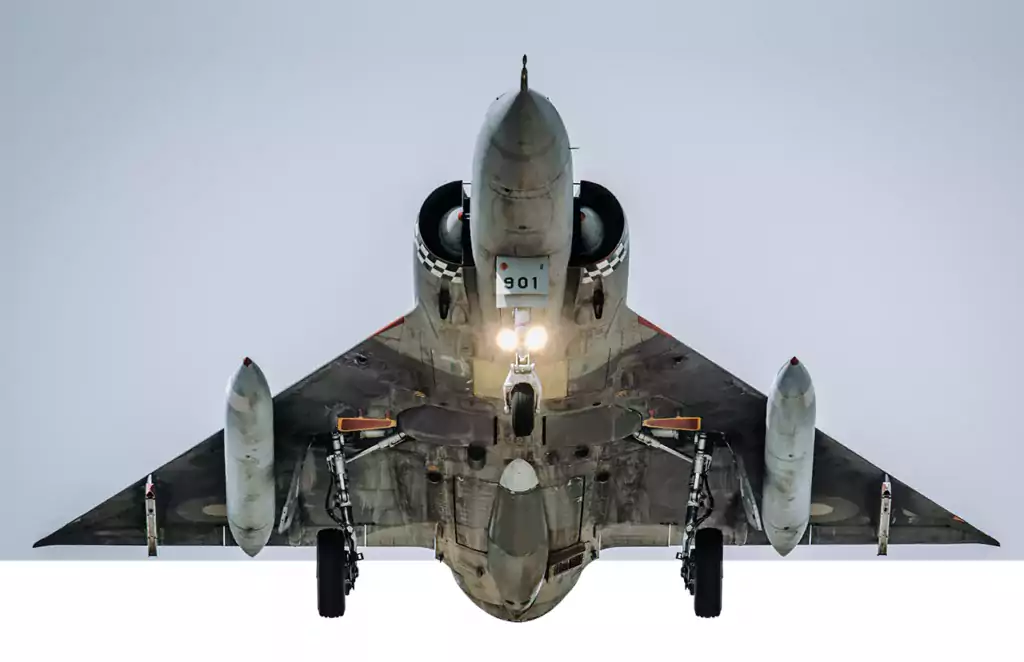Air Cdre Kaiser Tufail (Retd) presents a brief analysis and evaluation of Pakistan’s air power capabilities, and provides an overview of the available wherewithal to deal with contemporary challenges. In addition to PAF, it touches upon the capabilities of Army Aviation and Naval Air Arm. The main thrust is on PAF’s fleet modernization program and focuses on air-to-air and air-to-ground stand-off weapon delivery capabilities whose importance was highlighted in ‘Ops Swift Retort 2019.’ Fifth-generation fighter, transport, tanker, combat search & rescue and electronic warfare capabilities are also touched upon, within constraints of discretion. An overview of ground and airborne radars is also provided. The varied fixed wing and rotary wing assets of Army Aviation and Naval Air Arm are briefly discussed.
Pakistan Air Force
Having risen from almost token beginnings, Pakistan Air Force transformed itself into a combat hardened air force in a very short period. It has managed to keep the aircraft fleet fully operational at all times, despite repeated sanctions by its principal hardware supplier. Its small size belies its strength, which is buoyed by well-trained manpower imbibed with a high state of morale and self-discipline. With regard to weapon systems, PAF is well on the way to modernization of its fleet to the so-called 4+ generation of fighters, though half of it still includes F-7P/PG (Chinese derivatives of the early model MiG-21F) and Mirage III/ V that first flew in the mid-fifties.
The Mirages have had a long service in PAF, which began in 1968. Out of a total of 200 Mirages that have flown in PAF, 96 were purchased new, while 104 were acquired and refurbished from ex-Australian, French, Lebanese and Libyan stocks. Over 60 non-airworthy Mirages obtained from Australia, Libya and Spain were cannibalized for spares, and continue to sustain the fleet as they soldier on beyond the fifth decade. More than a dozen different sub-types of Mirages have been modified to perform specialist roles including Forward Looking Infra-Red (FLIR)-aided night strikes and precision stand-off bombing.
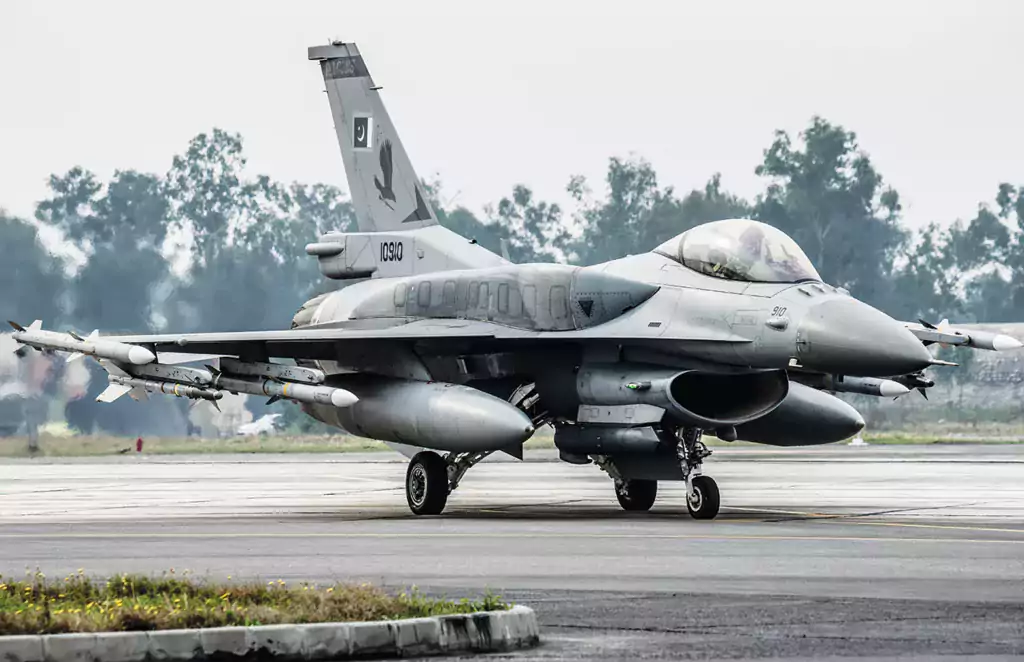
The F-7Ps inducted in 1988, have served in the point defence intercept and close air support roles. As a nifty fighter that is fairly tolerant of mistakes, it has also performed usefully for operational conversion of novice fighter pilots. More than a 100 F-7Ps had been procured till arrival of the much-modified F-7PG in 2001. The new version, with a more powerful engine, double-delta wing planform, and maneuvering flaps vastly improved upon the performance of its progenitor. The year 2001 also marked the retirement of the aging F-6, of which 260 had seen service in PAF, spread over 35 years.
PAF’s ongoing fleet modernization program aims at a two-type fighter inventory, including F-16A (MLU)/F-16C (Blk 52), and more than 200 Pak-China JF-17 Thunder. The program entails an ongoing replacement of the F-7P/PG and Mirage III/5 with the JF-17. The JF-17, in its Block III iteration (with AESA radar, HMD/S, additional sensor station, and integral electronic warfare suite) is expected to be the workhorse of PAF over the next two decades, at least. In the interim, design work on a fifth generation fighter continues under the Project Azm (Resolve) that was launched in early 2018.
Significant air-to-ground capabilities of both the F-16 and JF-17 rest on their state-of-the-art Sniper and Asel targeting pods. These pods allow aircrews’ to detect, identify and engage targets outside the range of most enemy air defences. The pods incorporate a high definition FLIR-seeker, as well as visible-light HDTV, laser spot tracker, laser marker, video data link, and a digital data recorder. The FLIR allows observation and tracking through smoke and haze, and in low light or no light conditions. The video of the target can be shared with formation members, or directly with army formation commanders in real time through data link.
A modernized PAF featuring a full-fleet BVR intercept capability, with data-link support from ground and airborne early-warning radar platforms, targeting sensors for day/night precision attack, integrated electronic warfare suites, and an array of stand-off weapons against land and maritime targets, is expected to take shape within a decade. With the added ability of the JF-17 and Mirage III/V to launch cruise missiles having conventional or unconventional warheads, PAF has unequivocally moved beyond the largely tactical role it had in the past.
Transport aircraft for combat support operations include C-130B/E and CN-235. Rapid deployment of combat units to their forward locations during any contingency is the most vital aspect of these operations. Il-78 aerial tankers provide in-flight refuelling to Mirage IIIEA and JF-17 aircraft employing the probe-and-drogue method; the huge tankers can also perform a useful heavy-lift or over-sized cargo transportation role.
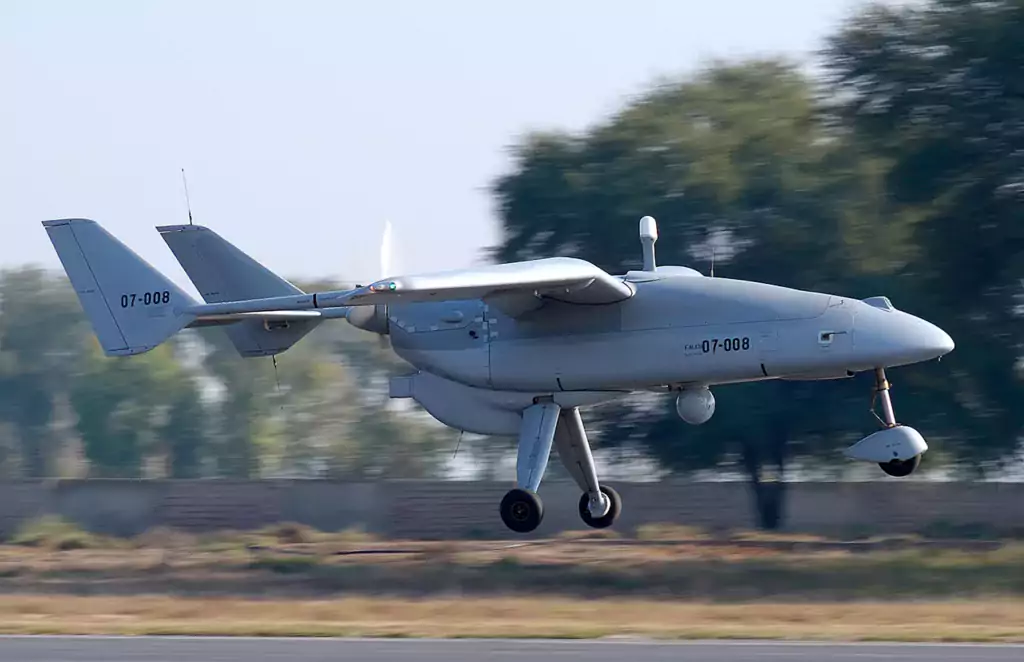
Dassault DA-20 Falcon electronic warfare aircraft provide radar and radio communications jamming, and other electronic support measures. A small element of AW-139 and Mi-171 helicopters provides aircrew combat search and rescue (CSAR) service at each flying base. The older SA-319 Alouettes have been assigned a training role, pending their eventual phasing out. For pilot training, PAF uses the locally manufactured Super Mushshak primary piston trainer, Cessna T-37 basic jet trainer, and the Pak-Chinese K-8 advanced jet trainer which replaced the FT-5 (dual-seat MiG-17). The PAF Academy aerobatics team Sherdils performs air displays on the K-8. Unmanned Aerial Vehicles (UAVs) continue to supplement manned fighters for reconnaissance missions. Their ability to stay aloft for long durations, and transmission of reconnaissance imagery to field formations through data link, are seen as major capability upgrades. The success of the COIN campaign in terrorist hideouts near the Afghan frontier has been, in large part, due to the vastly improved situational awareness for troops on ground as well as aircrew in the air.
Defence of Pakistan’s air space is the responsibility of PAF’s Air Defence Command, with surveillance, identification, and fire control orders being within its sole ambit. Airspace is surveilled by airborne, as well as ground-based early warning radar systems. SAAB 2000 Erieye and Chinese ZDK-03 Airborne Early Warning & Control (AEWC) aircraft provide over-the-horizon surveillance in the mountainous areas of the north, as well as vast stretches of the Arabian Sea. An assortment of Lockheed-Martin TPS-77, Westinghouse TPS-43G, and Chinese Nanjing YLC-2 radars provide ground-based surveillance at medium to high altitudes, while YLC-6 and Siemens MPDR-45/60/90 radars cover low altitudes. The low-budget, ‘eyes and ears’ Mobile Observer Units are used to plug in the gaps in areas where terrain or logistics resupply constraints preclude deployment of radars. The inputs from this complete array of sensors are fed through several Generic Mission Control Centers, to the four fully automated Air Defence Sectors for further kinetic action, as required.
The three services have their own terminal defence weapons. PAF utilizes the vehicle-mounted Spada 2000 surface-to-air missiles (SAMs), along with a mix of Mistral and the locally developed Anza shoulder-fired missiles, for defence of air bases and radar sites. The air defence missiles at PAF bases are also supplemented by the Army’s radar-controlled AAA. The Army covers its deployed field formations with the LY-80 SAMs, along with Anza and Stinger missiles. The Navy provides cover to its shore establishments with the Mistral and FN-6 missiles.
Pakistan Naval Aviation
The PN’s land-based Naval Air Arm was established in 1975 as a result of lessons learnt after the 1971 war, when the PN surface fleet took serious losses in the absence of dedicated maritime patrol and rapid response platforms, to deal with evolving threats at sea. The air arm focuses on maritime patrol, anti-surface vessel warfare, and anti-submarine warfare with the help of fixed-wing aircraft, as well as helicopters. All three roles are comprehensively performed by the Harpoon-armed P-3C Orion, whose reach extends over vast stretches of the Indian Ocean and the Arabian Sea.
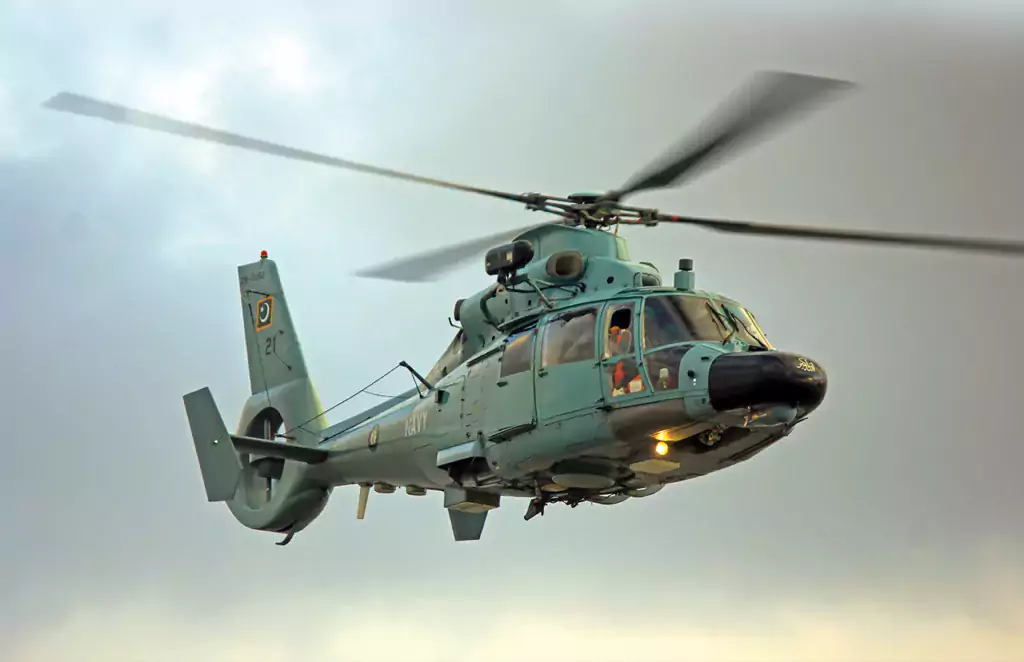
The specially configured ATR-72 can perform maritime patrol as well as ASW, while the legacy Fokker F-27 performs maritime patrol tasks, albeit over shorter ranges. ASV warfare in high-threat environments – like an enemy surface task group defended by fighter aircraft – is conducted by a squadron of PAF’s latest JF-17s, equipped with the C-802 anti-ship missile. It was recognized that not only did the special skills required to operate and maintain a multi-role fighter lay with the air force, but the optimal utilization of such a platform could not be justified were it to be utilized in a single role by the navy. The existing arrangement has worked out to the satisfaction of both services for over 35 years, when PAF’s AM-39 Exocet-equipped Mirage V PA-3 first assumed the maritime attack role. Excellent cooperation exists between the two services, and PAF regularly participates in PN exercises.
An important role of defensive screening of own naval task force against surface and sub-surface threats, is performed by a squadron each of Harbin Z-9 (in the ASW role) and Westland Sea King helicopters (in ASV and ASW roles). Search and rescue, and command liaison tasks are performed by SA-319 Alouette helicopters. The PN frigates are equipped to embark one helicopter each for any of the selected tasks. The PN helicopters have also played a noteworthy role in periodic flood relief operations in the coastal areas of Pakistan. BN Defender aircraft are utilized by the PN-controlled Maritime Security Agency for enforcement of maritime law in international waters, as well as policing of Pakistan’s exclusive economic zone.
Pakistan Army Aviation
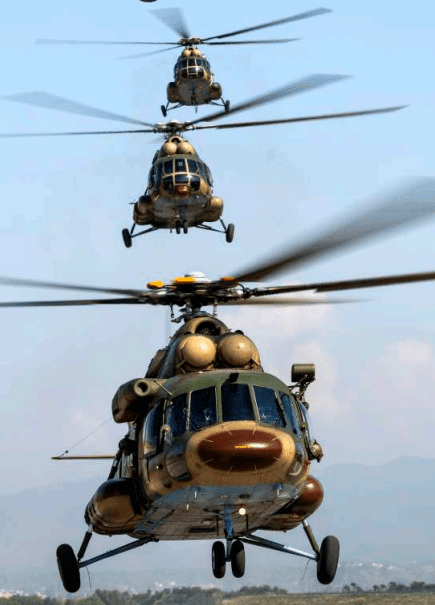
Beginning as an Air Observation Post (AOP) flight of Artillery in 1947 with just four Auster Mk-V aircraft, the unit was established as a separate Aviation Corps of Pakistan Army much later, in 1976. During the 1965 and 1971 wars, this aviation component provided sterling combat support with the L-19 Bird Dog AOP aircraft, and OH-13 Sioux and Mi-8 helicopters. The Corps was raised to the status of a Command in 1988, with a General Officer Commanding heading the Aviation Command. It has grown into a sizeable supporting arm of the Army, with a mix of helicopters and fixed-wing aircraft.
The most lethal component of the helicopter inventory are the gunships which include AH-1F/Z Cobra, AS-550 Fennec and Mi-35; additional Turkish T-129 are on order. The gunships have seen effective action in COIN operations in Pakistani tribal areas abutting Afghanistan. Troop and freight transport helicopters include the AW-139, Bell 412, Mi-17/171, and SA-330 Puma. During peacetime, these helicopters have been immensely useful in disaster relief operations like floods and earthquakes, which are not infrequent in the country. Light utility helicopters include the AS-350 Écureuil, Bell 206 Jet Ranger, SA-319 Alouette III, and SA-315 Lama. Some of these light helicopters are also operated by para-military forces like Coast Guards, Rangers and Frontier Corps, but maintained by Army Aviation. Helicopter training is done on Schweizer 300 and Enstrom 280.
The fixed-wing inventory of the Army Aviation includes several types of piston, turboprop and executive jets of the ‘general aviation’ category. They are used mostly for the purpose of transportation of senior formation commanders for meetings with the General Staff at GHQ. One of the noteworthy fixed-wing aircraft is the locally-manufactured MFI-17 Mushshak primary trainer, of which over 100 continue to operate since their induction in the Army in 1976. Besides primary training of pilots, it serves useful operational tasks of forward air control, artillery spotting, and light communications.
The Army Aviation has to its credit several successful UN peace-keeping deployments in Burundi, Sierra Leone, Somalia, and Sudan. It has also carried out some daring high altitude combat support and rescue missions in the mountainous areas of northern Pakistan.
Other Assets
Civil Aviation assets, including all civil aircraft registered in Pakistan, are liable to be mustered during any emergency, as per the country’s legal stipulations. In the past wars, aircraft of the national airline were used for flying-in military equipment and spares from other countries.
Aircraft were also put at the disposal of the navy for maritime reconnaissance at a time when the Naval Air Arm did not exist. In any future war, the Ministry of Defence can count on about two dozen airliners and twice as many general aviation aircraft to be available for transportation of men and material, for search and rescue, and for reconnaissance purposes.
Conclusion
As a pivotal enabler of ground operations, PAF has the ability to inflict casualties on enemy forces at stand-off ranges with precision weapons, thus preventing own troops from being exposed to the enemy’s greater capacity of direct ground fire. The accuracy and increased level of intensity of air intervention now possible, allows a higher operational tempo that is highly desirable in a short conventional war. While support to surface forces remains an integral part of PAF’s doctrine, the service remains cognizant of the need for achieving optimal control of the air over the area of ground or maritime operations. An overall favorable air situation, along with local air superiority in the area of critical battles, is well within the capabilities of today’s PAF. All components of Pakistan’s air power remains cognizant of the changing dynamics of aerial warfare, and is well up to the challenge of sophisticated and technology-intensive demands it is likely to face in the coming years.
